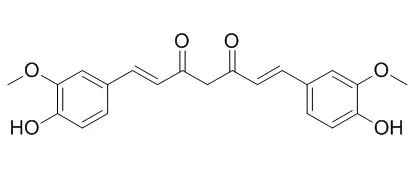| Description: |
Curcumin is a natural phenolic compound with diverse pharmacologic effects including antitumour, anti-bacteria, anti-fungicidal ,anti-edemic, hepatoprotective, anti-inflammatory, antioxidant, antiproliferative and antiangiogenic activities. Curcumin is an inhibitor of p300 histone acetylatransferase ((HATs)) and also shows inhibitory effects on NF-κB and MAPKs.Curcumin application causes markedly fast wound closure with well-formed granulation tissue dominated by fibroblast proliferation, collagen deposition, and complete early regenerated epithelial layer.
|
| Targets: |
DNA Methyltransferase | TNF-α | IFN-γ | IL Receptor | Nrf2 | HO-1 | GLUT | Caspase | STAT | NF-kB | HDAC | VEGFR | TGF-β/Smad |
| In vitro: |
| Toxicol Lett. 2015 Mar 18;233(3):227-38. | | Curcumin induces oxidation-dependent cell cycle arrest mediated by SIRT7 inhibition of rDNA transcription in human aortic smooth muscle cells.[Pubmed: 25644192] | It is widely accepted that abnormal accumulation of vascular smooth muscle cells (VSMCs) may promote atherosclerosis and post-angioplasty restenosis. The use of some plant polyphenols with potent antiproliferative activities may be considered as a therapeutic intervention to diminish/prevent the development of cardiovascular pathologies.
METHODS AND RESULTS:
In the present study, VSMC response to Curcumin treatment was evaluated. 5 μM Curcumin elicited a cytostatic effect, which was accompanied by protein carbonylation, oxidative DNA damage and changes in the nucleolar activity (the size and number of nucleoli, nucleolar protein levels and their localization). The levels of p53 and p21 were elevated. However, this was independent of DNA DSBs. Curcumin caused inhibition of rDNA transcription, which could be due to SIRT7 downregulation, site-specific methylation of RNA18S5 gene promoter or both. Curcumin-induced DNA methyltransferase 2 (DNMT2) upregulation was also shown. DNMT2-mediated RNA methylation could promote RNA stabilization upon Curcumin treatment.
CONCLUSIONS:
In conclusion, a nucleolus-focused cytostatic action of Curcumin at a low micromolar concentration range, which could be feasibly achieved through dietary means, was established in VSMCs and we propose a novel mechanism underlying this action. We believe that our results may contribute to better understanding of the biological and pharmacological effects of Curcumin on the human cardiovascular system. | | Anticancer Res. 2015 Feb;35(2):645-51. | | Potential anticancer properties and mechanisms of action of curcumin.[Pubmed: 25667441] | Curcumin, a yellow substance belonging to the polyphenols superfamily, is the active component of turmeric, a common Indian spice, which is derived from the dried rhizome of the Curcuma longa plant. Numerous studies have demonstrated that Curcumin possesses anti-oxidant, anti-inflammatory and anticancerous properties.
The purpose of this review is to focus on the anti-tumor effects of Curcumin.
METHODS AND RESULTS:
Curcumin inhibits the STAT3 and NF-κB signaling pathways, which play key-roles in cancer development and progression. Also, inhibition of Sp-1 and its housekeeping gene expressions may serve as an important hypothesis to prevent cancer formation, migration, and invasion. Recent data have suggested that Curcumin may act by suppressing the Sp-1 activation and its downstream genes, including ADEM10, calmodulin, EPHB2, HDAC4, and SEPP1 in a concentration-dependent manner in colorectal cancer cell lines; these results are consistent with other studies, which have reported that Curcumin could suppress the Sp-1 activity in bladder cancer and could decrease DNA binding activity of Sp-1 in non-small cell lung carcinoma cells. Recent data advocate that ER stress and autophagy may as well play a role in the apoptosis process, which is induced by the Curcumin analogue B19 in an epithelial ovarian tumor cell line and that autophagy inhibition could increase Curcumin analogue-induced apoptosis by inducing severe ER stress.
CONCLUSIONS:
The ability of Curcumin to induce apoptosis in tumor cells and its anti-angiogenic potential will be discussed in this review. |
|
| In vivo: |
| Toxicol Appl Pharmacol. 2015 Feb 1;282(3):297-310. | | Curcumin enhances recovery of pancreatic islets from cellular stress induced inflammation and apoptosis in diabetic rats.[Pubmed: 25541178] | The phytochemical, Curcumin, has been reported to play many beneficial roles. However, under diabetic conditions, the detail mechanism of its beneficial action in the glucose homeostasis regulatory organ, pancreas, is poorly understood.
METHODS AND RESULTS:
The present study has been designed and carried out to explore the role of Curcumin in the pancreatic tissue of STZ induced and cellular stress mediated diabetes in eight weeks old male Wistar rats. Diabetes was induced with a single intraperitoneal dose of STZ (65 mg/kg body weight). Post to diabetes induction, animals were treated with Curcumin at a dose of 100 mg/kg body weight for eight weeks. Underlying molecular and cellular mechanism was determined using various biochemical assays, DNA fragmentation, FACS, histology, immunoblotting and ELISA. Treatment with Curcumin reduced blood glucose level, increased plasma insulin and mitigated oxidative stress related markers. In vivo and in vitro experimental results revealed increased levels of proinflammatory cytokines (TNF-α, IL1-β and IFN-γ), reduced level of cellular defense proteins (Nrf-2 and HO-1) and glucose transporter (GLUT-2) along with enhanced levels of signaling molecules of ER stress dependent and independent apoptosis (cleaved Caspase-12/9/8/3) in STZ administered group. Treatment with Curcumin ameliorated all the adverse changes and helps the organ back to its normal physiology.
CONCLUSIONS:
Results suggest that Curcumin protects pancreatic beta-cells by attenuating inflammatory responses, and inhibiting ER/mitochondrial dependent and independent pathways of apoptosis and crosstalk between them. This uniqueness and absence of any detectable adverse effect proposes the possibility of using this molecule as an effective protector in the cellular stress mediated diabetes mellitus. |
|






 Cell. 2018 Jan 11;172(1-2):249-261.e12. doi: 10.1016/j.cell.2017.12.019.IF=36.216(2019)
Cell. 2018 Jan 11;172(1-2):249-261.e12. doi: 10.1016/j.cell.2017.12.019.IF=36.216(2019) Cell Metab. 2020 Mar 3;31(3):534-548.e5. doi: 10.1016/j.cmet.2020.01.002.IF=22.415(2019)
Cell Metab. 2020 Mar 3;31(3):534-548.e5. doi: 10.1016/j.cmet.2020.01.002.IF=22.415(2019) Mol Cell. 2017 Nov 16;68(4):673-685.e6. doi: 10.1016/j.molcel.2017.10.022.IF=14.548(2019)
Mol Cell. 2017 Nov 16;68(4):673-685.e6. doi: 10.1016/j.molcel.2017.10.022.IF=14.548(2019)